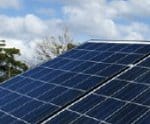A new report shows home solar power systems can be a significant peak electricity demand reduction strategy in meeting afternoon mains grid demand during summer months.
Texas-based energy research firm Pecan Street Research Institute studied the production and consumption of 52 single-family solar households in Austin. 24 had south-facing* solar arrays, 14 with west-facing arrays, and 14 had a combination of west and south-facing solar panel systems.
Counting only the PV generated electricity actually used in the home, the households averaged a 58 percent peak demand reduction for electricity from the grid.
South-facing solar panels cut peak demand from the grid by 54%, while west-facing systems reduced their homes’ peak demand from the grid by 65%.
“These findings suggest that rooftop solar systems can produce large summer peak reductions that benefit utilities and customers alike without requiring customers to change their behavior or sacrifice comfort,” said the report’s lead author, Pecan Street CEO Brewster McCracken.
Over an entire day, 64% of the electricity produced by the rooftop systems was consumed on-site and 36% was returned to the grid.
The value of west facing systems during summer months really came to the fore through the study. During summer peak demand hours (3-7 pm), west-facing systems produced 49 percent more electricity during those hours than did south-facing systems. However, over an entire year, south facing systems will produce more power.
With network charges (infrastructure) being the major driver of electricity price rises in recent years in Australia; results like this send a clear signal that residential and commercial solar can play a major role in reining in these costs. $11 billion has been spent on energy infrastructure in Australia that is only used four days out of every year – mainly to support the growth of air-conditioner usage.
*In the northern hemisphere, south-facing is considered optimal for solar PV, whereas in the southern hemisphere northerly orientation is generally considered ideal.












































